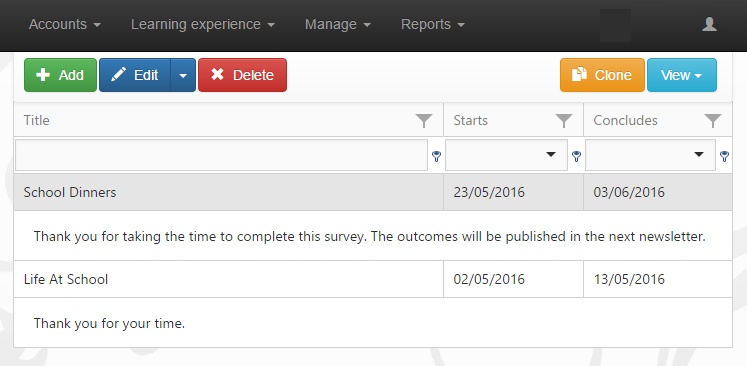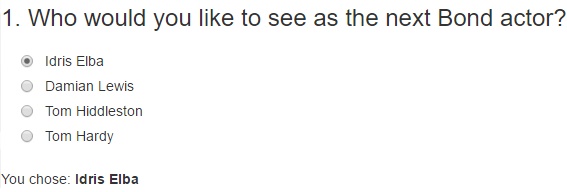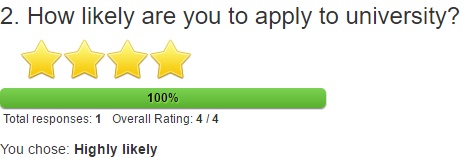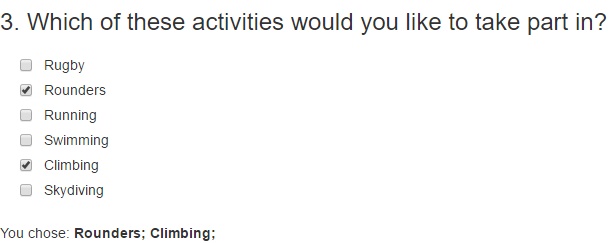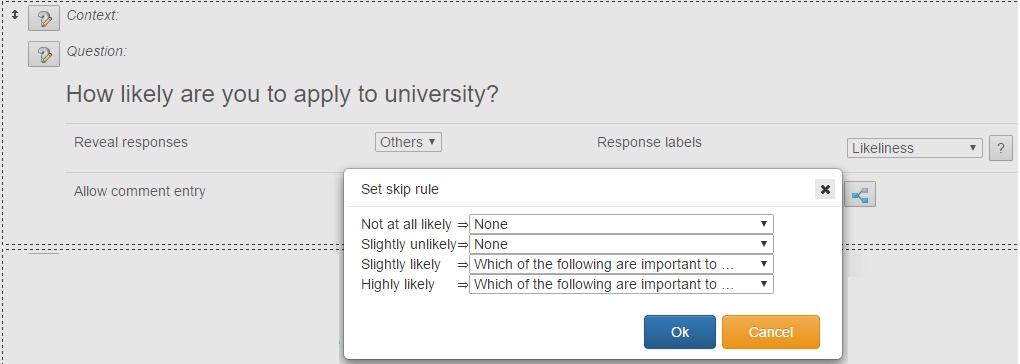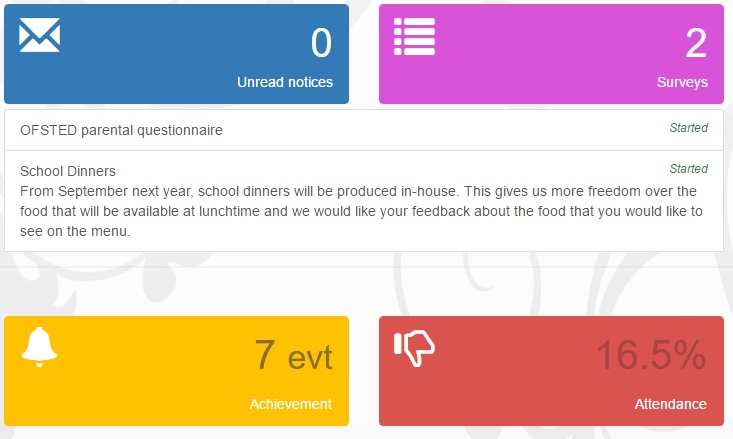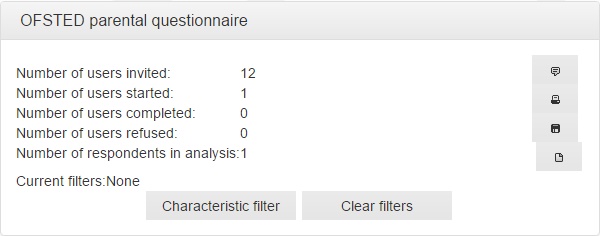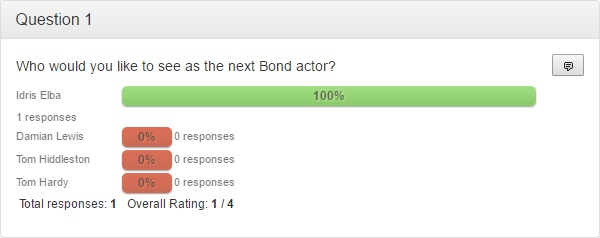Difference between revisions of "Surveys"
| (48 intermediate revisions by the same user not shown) | |||
| Line 1: | Line 1: | ||
| − | {{Additional_module | + | {{Additional_module}} |
| − | Insight can be used to create and publish surveys to parents or pupils. When there is an available survey, users will be prompted to take part when they log in, and the results can analysed. <br> <br> | + | Surveys is an additional module in Insight. It can be used to create and publish surveys to parents or pupils. When there is an available survey, users will be prompted to take part when they log in, and the results can analysed. <br> <br> |
| − | + | As Surveys is an additional module of Insight, a separate charge applies. Please contact <span class="plainlinks">[mailto:sales@tascsoftware.co.uk sales@tascsoftware.co.uk]</span> for further information. <br> <br> | |
| − | + | =Creating a Survey= | |
The survey page will show a list of all of the surveys that have been created so far. <br> <br> | The survey page will show a list of all of the surveys that have been created so far. <br> <br> | ||
| − | [[Image: | + | [[Image:surveys_page1.jpg]] <br> <br> |
| − | + | The Add button at the top left of the page is used to create new surveys. Each survey needs a title, a start date and an end date. Surveys can also be given optional intro and completion notes. <br> <br> | |
| − | + | Once a survey has been created it needs to have questions assigned to it. <br> <br> | |
| − | + | ||
| − | + | ==Types of Questions== | |
| − | + | ||
| − | + | A survey needs to have questions assigned to it. There are 5 types of questions available: <br> | |
| − | + | ||
| − | + | ===Single Choice (equal value answers)=== | |
| − | + | ||
| − | + | Users may only select one answer. Each answer has equal value e.g. <br> | |
| − | + | <div>[[Image:s_question1.jpg]]</div> <br> <br> | |
| − | + | ||
| − | + | ===Single Choice (ordered value answers)=== | |
| − | + | ||
| − | + | Users may only select one answer. Answers are ordered from 'worst' to 'best' e.g. <br> | |
| − | + | <div>[[Image:s_question2a.jpg]]</div> <br> <br> | |
| − | + | ||
| − | + | ===Multiple Choice=== | |
| − | |||
| − | |||
| − | + | Users may select multiple answers. Each answer has equal value e.g. <br> | |
| + | <div>[[Image:s_question3.jpg]]</div> <br> <br> | ||
| − | + | ===Matrix=== | |
| − | + | Users will answer the same question several times and can only choose one answer each time. Each answer has equal value e.g. <br> | |
| + | <div>[[Image:s_question4.jpg]]</div> <br> <br> | ||
| − | + | ==Adding Questions to a Survey== | |
| − | + | Questions are added to a survey by selecting the survey then clicking the Arrow on the Edit button, then selecting the Questions option. <br> <br> | |
| − | + | Each question must be typed and an optional context can also be added to each question. A set of response labels must be selected, which are the responses that users are able to select when answering the survey question. The response labels determine what format the question will appear in; 'Check' type response labels are for multiple choice questions. Star and Option types are for single or matrix answers. <br> <br> | |
| − | + | When selecting an 'Option' type set of response labels, a field will appear called "Matrix options". This is used to configure Matrix type questions. Each statement should be typed into the Matrix Options field, separated by a semi-colon e.g. <br> | |
| + | ''My child feels safe at school ; My child is making good progress at this school ; This school meets my child’s particular needs'' <br> <br> | ||
| − | + | <div>[[Image:survey_questions1.jpg]]</div> <br> | |
| − | Skip rules can be used if you want users to skip some questions if they give particular answers. For example, if you have a question "How | + | Skip rules can be used if you want users to skip some questions if they give particular answers. For example, if you have a question "How likely are you to go apply to university?" and a user answers "Not at all", then there isn't much point in asking which university they are thinking about applying to. <br> <br> |
Click the Skip Rules Button and a window will open showing the various answers available, according to the Response Labels. For each possible answer, you can decide which question the user will be taken to. If you select Completion, then the survey will be finished if/when the user selects that answer. <br> <br> | Click the Skip Rules Button and a window will open showing the various answers available, according to the Response Labels. For each possible answer, you can decide which question the user will be taken to. If you select Completion, then the survey will be finished if/when the user selects that answer. <br> <br> | ||
| − | [[Image: | + | [[Image:surveys_skip_rules1.jpg]] <br> <br> |
| − | + | ==Response labels== | |
| − | + | Response labels are a set of answers that users may select from when answering questions on a survey. A few response labels are provided with Insight as default and more can be added by clicking View > Response labels. <br> <br> | |
| + | |||
| + | A new set of response labels needs a title and a Display. The display determines the type of question (see above). Response labels that are 'Check' are used for multiple choice questions. 'Star' and 'Option' type response labels are used for either Single or Matrix type questions. <br> <br> | ||
There are 3 buttons next to each of the Response Labels. <br> <br> | There are 3 buttons next to each of the Response Labels. <br> <br> | ||
| Line 63: | Line 66: | ||
!Button!!Effect | !Button!!Effect | ||
|- | |- | ||
| − | |[[Image: | + | |[[Image:edit_label_type1.jpg|36px]]||Edit the name and display of the Response Label |
|- | |- | ||
| − | |[[Image: | + | |[[Image:edit_labels1.jpg|36px]]||Edit the answers available in the Response Label |
|- | |- | ||
| − | |[[Image: | + | |[[Image:delete_label1.jpg|36px]]||Delete the Response Label |
|} <br> | |} <br> | ||
| − | + | ==Participants== | |
| + | |||
| + | Users must be invited to take part in Surveys before they are able to see the survey or answer any questions. Users can be invited by clicking the arrows next to the Edit button then selecting Participants. | ||
| + | |||
| + | Once you have created your survey, it must be issued to users. Select the survey and click the Participants Button. This will open a window where you can select students. <br> <br> | ||
| − | + | The survey will be issued to every user that is linked to the students you select. Use the groupings on the left to select specific groups of students. You can either click the Add All Button to add all pupils from a group, or click on specific pupil names to add only those pupils. <br> <br> | |
| − | + | =How the survey appears to users= | |
| − | + | Users will see a Surveys section at the top of the [[snapshot]] page. This allows users to select and participate in surveys. <br> <br> | |
| − | + | Users can then answer each question, and add comments and see the percentage of people that selected the same answer as them (depending on the survey configuration). <br> <br> | |
| − | + | <div>[[Image:surveys_prompt1.jpg]]</div> <br> <br> | |
| − | = | + | =Analysing results= |
| − | + | To analyse the results of a survey go to the Surveys page and click View > Analyse. <br> <br> | |
| − | + | [[Image:survey_anylsis_overview1.jpg]] <br> <br> | |
| − | + | At the top of the analysis, you will see a summary of the users that have been involved and some buttons. You can see what each of the buttons do by hovering your mouse over them. <br> <br> | |
| − | + | [[Image:survey_anylsis_question1.jpg]] <br> <br> | |
| − | + | An analysis of each question will also be shown. You will be able to see the percentage of users that selected each answer and an overall rating for the answers that the users gave. If you click the Comment Button, you will see all of the comments entered by users. <br> <br> | |
| − | [[Category: | + | [[Category:Management]] |
[[Category:Features]] | [[Category:Features]] | ||
[[Category:Additional modules]] | [[Category:Additional modules]] | ||
Latest revision as of 13:36, 16 June 2017
| Additional Module |
Surveys is an additional module in Insight. It can be used to create and publish surveys to parents or pupils. When there is an available survey, users will be prompted to take part when they log in, and the results can analysed.
As Surveys is an additional module of Insight, a separate charge applies. Please contact sales@tascsoftware.co.uk for further information.
Contents
Creating a Survey
The survey page will show a list of all of the surveys that have been created so far.
The Add button at the top left of the page is used to create new surveys. Each survey needs a title, a start date and an end date. Surveys can also be given optional intro and completion notes.
Once a survey has been created it needs to have questions assigned to it.
Types of Questions
A survey needs to have questions assigned to it. There are 5 types of questions available:
Single Choice (equal value answers)
Users may only select one answer. Each answer has equal value e.g.
Single Choice (ordered value answers)
Users may only select one answer. Answers are ordered from 'worst' to 'best' e.g.
Multiple Choice
Users may select multiple answers. Each answer has equal value e.g.
Matrix
Users will answer the same question several times and can only choose one answer each time. Each answer has equal value e.g.
Adding Questions to a Survey
Questions are added to a survey by selecting the survey then clicking the Arrow on the Edit button, then selecting the Questions option.
Each question must be typed and an optional context can also be added to each question. A set of response labels must be selected, which are the responses that users are able to select when answering the survey question. The response labels determine what format the question will appear in; 'Check' type response labels are for multiple choice questions. Star and Option types are for single or matrix answers.
When selecting an 'Option' type set of response labels, a field will appear called "Matrix options". This is used to configure Matrix type questions. Each statement should be typed into the Matrix Options field, separated by a semi-colon e.g.
My child feels safe at school ; My child is making good progress at this school ; This school meets my child’s particular needs
Skip rules can be used if you want users to skip some questions if they give particular answers. For example, if you have a question "How likely are you to go apply to university?" and a user answers "Not at all", then there isn't much point in asking which university they are thinking about applying to.
Click the Skip Rules Button and a window will open showing the various answers available, according to the Response Labels. For each possible answer, you can decide which question the user will be taken to. If you select Completion, then the survey will be finished if/when the user selects that answer.
Response labels
Response labels are a set of answers that users may select from when answering questions on a survey. A few response labels are provided with Insight as default and more can be added by clicking View > Response labels.
A new set of response labels needs a title and a Display. The display determines the type of question (see above). Response labels that are 'Check' are used for multiple choice questions. 'Star' and 'Option' type response labels are used for either Single or Matrix type questions.
There are 3 buttons next to each of the Response Labels.
| Button | Effect |
|---|---|
Error creating thumbnail: File missing |
Edit the name and display of the Response Label |
| Edit the answers available in the Response Label | |
| Delete the Response Label |
Participants
Users must be invited to take part in Surveys before they are able to see the survey or answer any questions. Users can be invited by clicking the arrows next to the Edit button then selecting Participants.
Once you have created your survey, it must be issued to users. Select the survey and click the Participants Button. This will open a window where you can select students.
The survey will be issued to every user that is linked to the students you select. Use the groupings on the left to select specific groups of students. You can either click the Add All Button to add all pupils from a group, or click on specific pupil names to add only those pupils.
How the survey appears to users
Users will see a Surveys section at the top of the snapshot page. This allows users to select and participate in surveys.
Users can then answer each question, and add comments and see the percentage of people that selected the same answer as them (depending on the survey configuration).
Analysing results
To analyse the results of a survey go to the Surveys page and click View > Analyse.
At the top of the analysis, you will see a summary of the users that have been involved and some buttons. You can see what each of the buttons do by hovering your mouse over them.
An analysis of each question will also be shown. You will be able to see the percentage of users that selected each answer and an overall rating for the answers that the users gave. If you click the Comment Button, you will see all of the comments entered by users.
